The 10 weirdest moons in the solar system
Some of the most fascinating worlds in our cosmic neighborhood are not planets, but the moons that orbit around them.
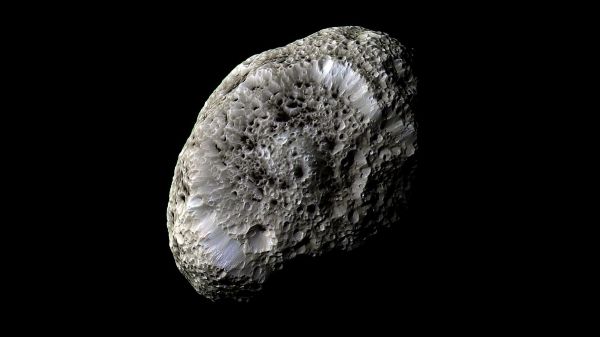
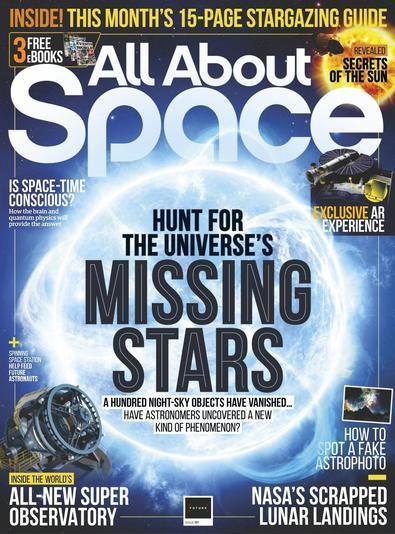
This article is brought to you by All About Space.
All About Space magazine takes you on an awe-inspiring journey through our solar system and beyond, from the amazing technology and spacecraft that enables humanity to venture into orbit, to the complexities of space science.
All but two of our solar system's planets have natural satellites of one sort or another. Earth's own moon, a beautiful but stark, dead world shaped by ancient volcanoes and countless impact craters, is undoubtedly the most familiar, but it's far from being the most interesting. Each of the outer solar system's giant planets is accompanied by a large retinue of satellites, many of which formed at the same time and from the same ice-rich material as the planets that host them. Although far from the sun and starved of solar heat and light, they nevertheless show as much variety as the planets themselves.
Here, we take a trip to visit some of the strangest and most exciting of these astonishing worlds. Some, such as Jupiter's Callisto and Saturn's Mimas, have been frozen solid for billions of years, but bear extraordinary scars from exposure to bombardment from space. Others, such as Saturn's shepherd moons Pan and Atlas and Neptune's lonely Nereid, have been affected throughout their history by interactions with their neighbors. Most excitingly, some of these exotic worlds have been heated by powerful tidal forces from their parent planets, triggering phases of violent activity like those which shaped Miranda, Uranus' Frankenstein moon. In some cases these forces are still at work today, creating fascinating bodies such as Jupiter's tortured Io and Saturn's icy Enceladus, whose placid exterior may even hide the greatest secret in the solar system: Extraterrestrial life itself.
Enceladus
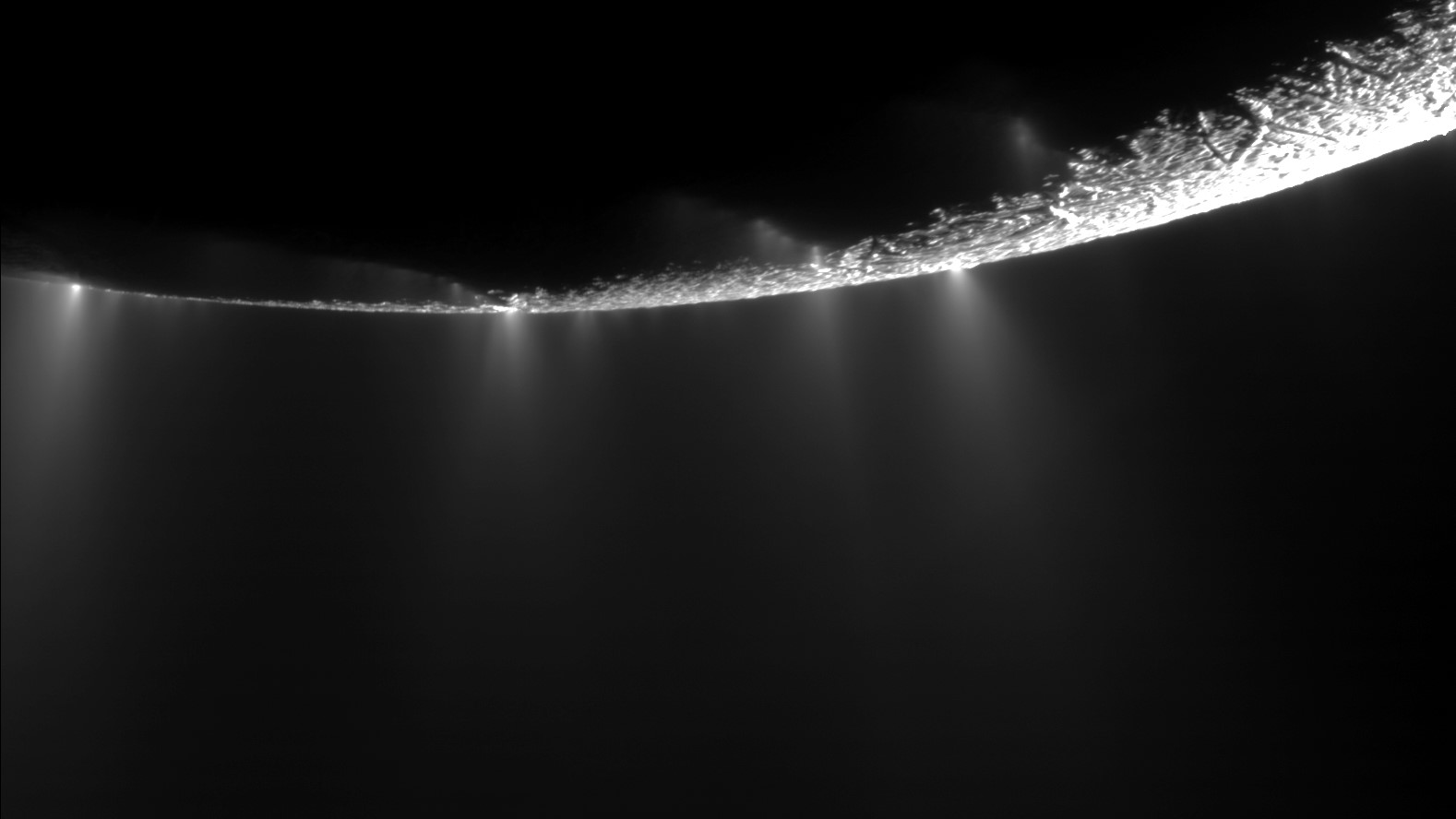
Since NASA's Cassini probe arrived at Saturn in 2004, the ringed planet's small inner satellite, Enceladus, has become one of the most intensely studied and debated worlds in the entire solar system. It owes its newfound fame to the discovery of huge plumes of water ice erupting into space along fissures in its southern hemisphere — a sure sign of liquid water lurking just beneath the moon's thin, icy crust.
The strange activity of Enceladus was suspected before Cassini's arrival thanks to earlier images that showed the moon has an unusually bright surface and craters that look like they are blanketed in snow. Nevertheless, the discovery of the ice plumes—initially made when Cassini flew straight through one—was a spectacular confirmation that Enceladus is an active world.
With a diameter of 313 miles (504 km) and a rock/ice composition, Enceladus should have frozen solid billions of years ago, like many of its neighbors in the Saturnian system. But tidal forces caused by a gravitational tug of war between Saturn and a larger moon, Dione, keep the moon's interior warm and active, making it a prime target in the hunt for life in the solar system.
While much of the water ice falls back to cover the surface, a substantial amount escapes from the weak gravity and enters orbit around Saturn. Here, it spreads out to form the donut-shaped E Ring — the outermost and sparsest of Saturn's major rings.
Callisto
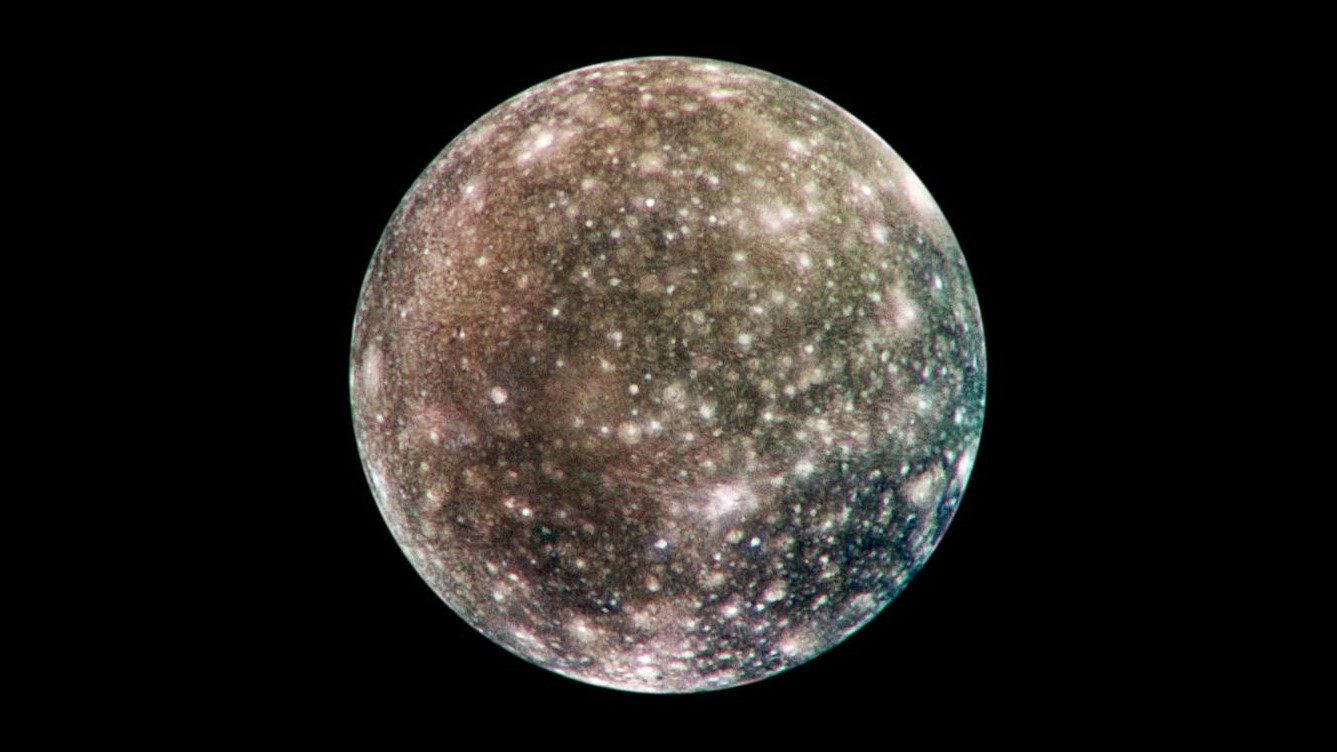
The outermost of Jupiter's Galilean moons, Callisto is the third-largest moon in the solar system, and is only slightly smaller than Mercury. Its main claim to fame is the title of most heavily cratered object in the solar system; its dark surface is covered in craters down to the limit of visibility, the deepest of which have exposed fresh ice from beneath and scattered bright 'ejecta' debris across the surface.
Sign up for the Live Science daily newsletter now
Get the world’s most fascinating discoveries delivered straight to your inbox.
Callisto owes its cratered surface to its location in the Jupiter system — the giant planet's gravity exerts a powerful influence, disrupting the orbits of passing comets and often pulling them to their doom, most spectacularly demonstrated in the 1994 impact of Comet Shoemaker-Levy 9.
Jupiter's larger moons are directly in the firing line, and end up soaking up more than their fair share of impacts, but Callisto's inner neighbors — influenced by greater tidal forces — have all experienced geological processes that wiped away most of their ancient craters. Callisto's surface, however, has remained essentially unchanged for more than 4.5 billion years, developing its dense landscape of overlapping craters across aeons.
Dactyl
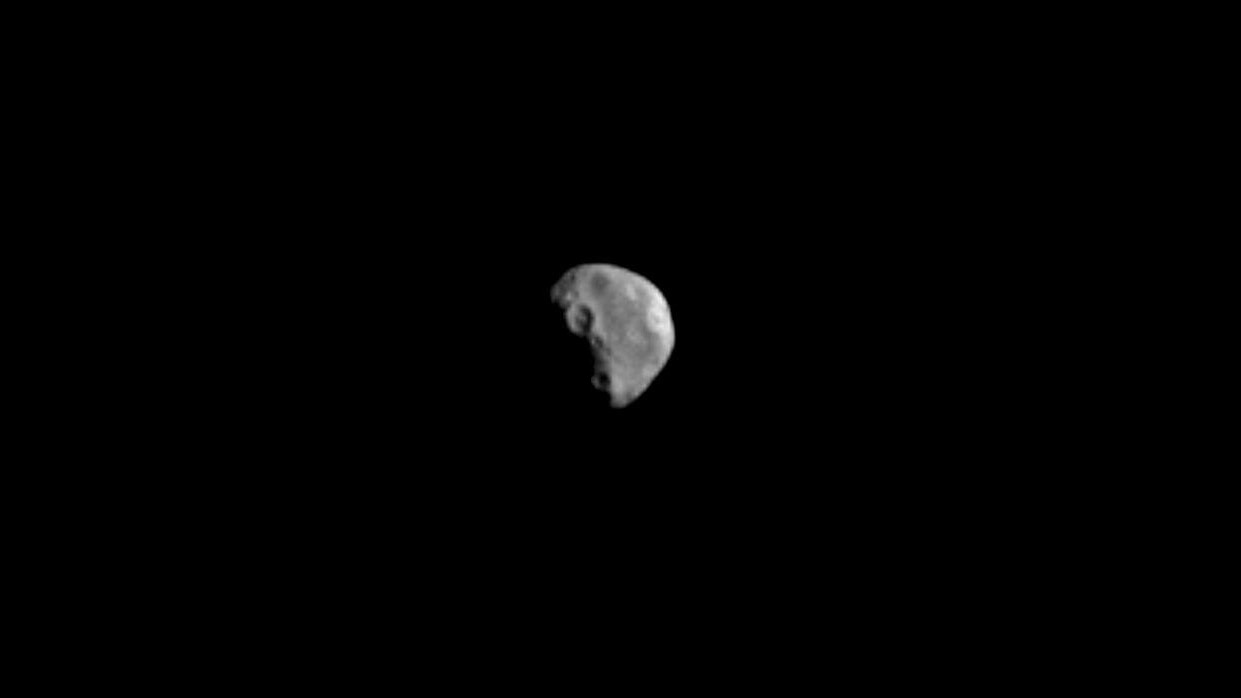
243 Ida, an asteroid designated as a minor planet, has a moon measuring just 0.99 miles (1.6 km) across on its longest axis. Thanks to the larger asteroid's weak gravity, Dactyl is unlikely to be an object captured into orbit, but the alternative — that Ida and Dactyl formed alongside each other — raises as many questions as it answers.
Ida is a major member of the Koronis family of over 300 asteroids, all of which share similar orbits. The family is thought to have formed 1 or 2 billion years ago during an asteroid collision. Dactyl could be a smaller fragment of debris from the collision that ended up in orbit around Ida, but there is a problem — computer models suggest Dactyl would almost certainly be destroyed by an impact from another asteroid.
So how can it be over a billion years old?
One theory is that the Koronis family is younger than it appears, and Ida's heavy cratering is due to a storm of impacts triggered in the original break-up. Another theory is that Dactyl has suffered a disrupting impact, but has pulled itself back together in its orbit, as found by NASA — which might explain its surprisingly spherical shape.
Iapetus
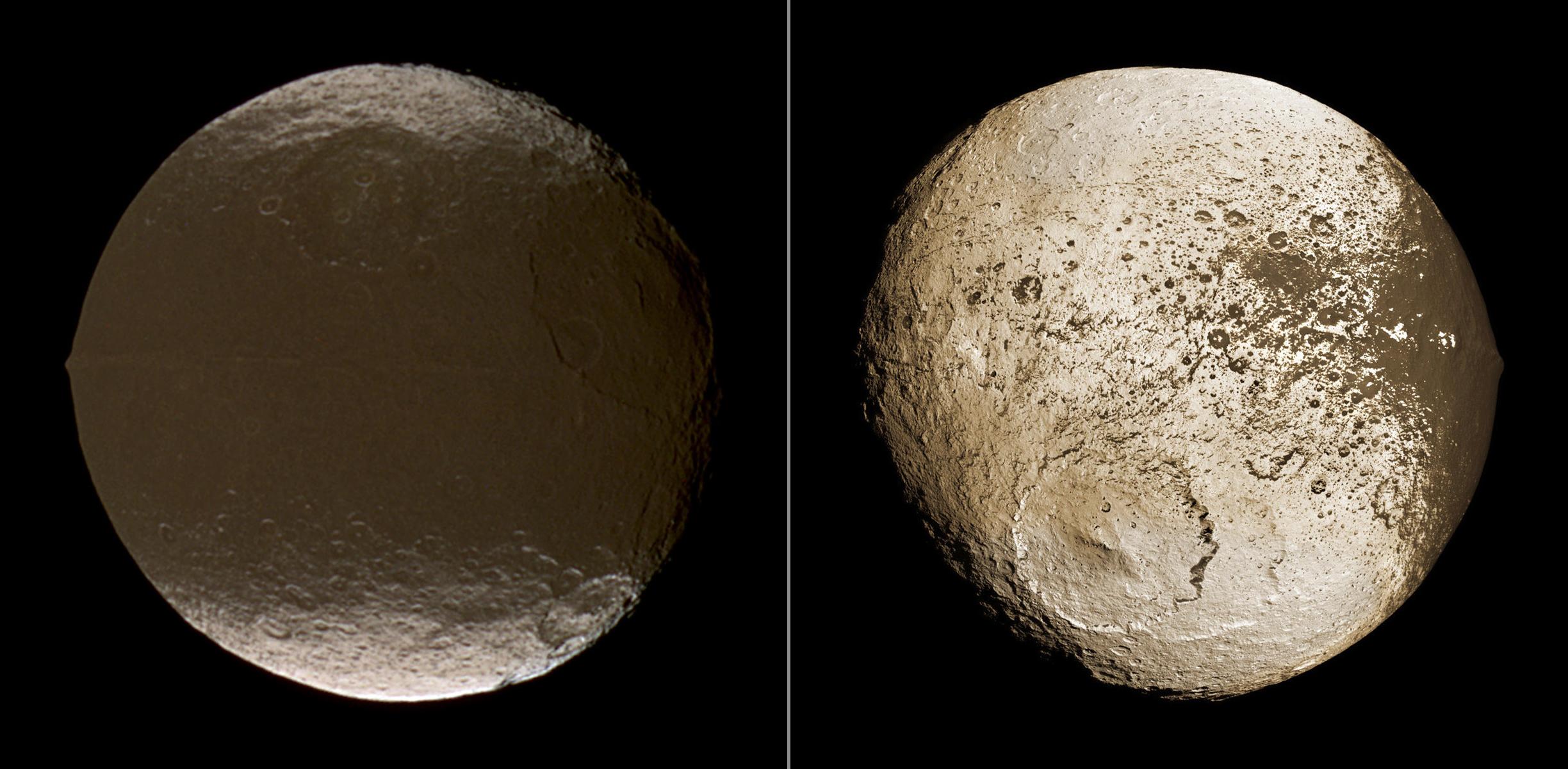
Iapetus has two distinct claims to a place in any list of weird satellites. The first became obvious when it was discovered in 1671 — it is much dimmer when seen on one side of its orbit compared to the other. Its leading hemisphere—the half that faces 'forwards' as it orbits Saturn—is dark brown, while its trailing hemisphere is light gray. One early theory to explain the color difference was that the leading side is covered in dust generated by tiny meteorite impacts on small outer moons, which spirals towards Saturn, as found by NASA.
However, images from Cassini reveal a more complex story. Most of the dark material seems to come from within Iapetus, left behind as dark 'lag' when dust-laden ice from the moon's surface sublimates — turns from solid to vapor. The process was likely started by dust from the outer moons accumulating on the leading hemisphere, but once it began, the tendency of the dark surface to absorb heat has caused a runaway sublimation effect.
Iapetus is also ringed by a mountainous equatorial ridge that is 8 miles (13 km) high and 12 miles (20 km) wide, giving the moon its distinctive walnut shape. The origins of this ridge are puzzling — some theories suggest it is a 'fossil' from a time when Iapetus span much faster and bulged out at the equator, while others think it could be debris from a ring system that once encircled the moon and collapsed onto its surface.
Nereid
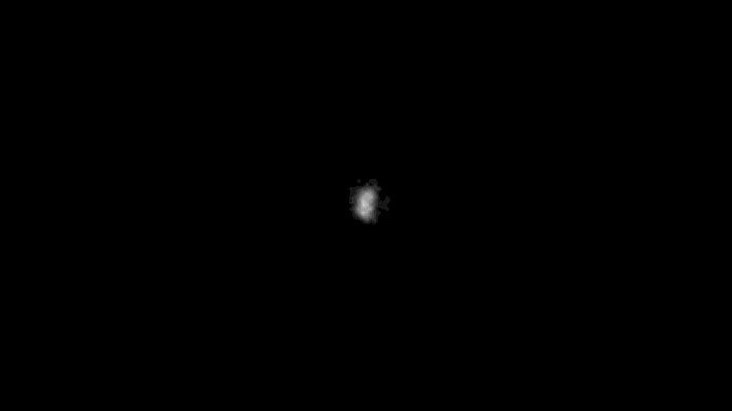
Nereid was the second moon found to orbit Neptune, and its claim to fame arises from its extreme orbit. Nereid's distance from Neptune ranges between 870,000 and 6 million miles (1.4 million and 9.7 million km). This orbit is usually typical of captured satellites — asteroids and comets swept up into highly eccentric orbits by the gravity of the giant outer planets — but Nereid's unusually large size suggests a rather more interesting story.
Evidence from Voyager 2's 1989 flyby suggests that Triton was captured into orbit from the nearby Kuiper Belt. Triton would have disrupted the orbits of Neptune's original moons, ejecting many of them. But many astronomers believe Nereid could be a survivor, clinging on at the edge of Neptune's gravitational reach.
Io
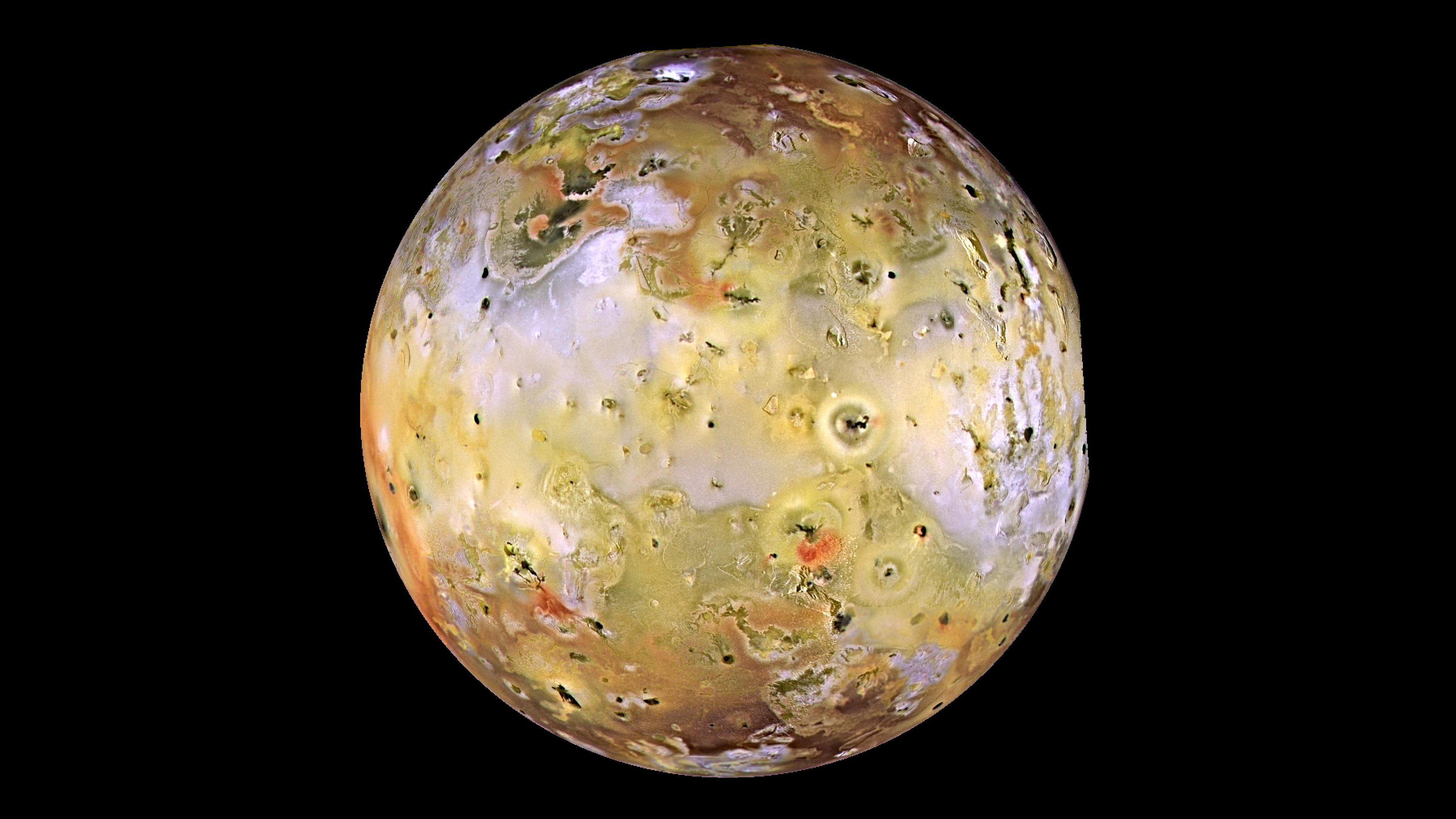
Io is the innermost of the four giant Galilean moons that orbit the solar system's largest planet, Jupiter. But while the outer three are — at least outwardly — placid, frozen worlds of rock and ice, Io's landscape is a virulent mix of yellows, reds, and browns, full of bizarre and ever-changing mineral formations created by sulfur that spills onto its surface in many forms. Io is the most volcanic world in the solar system. Io's strange surface was first observed during the Pioneer space probe flybys of the early 1970s, but its volcanic nature was only predicted weeks before the arrival of the Voyager 1 mission in 1979.
The moon is caught in a gravitational tug of war between its outer neighbors and Jupiter itself, and this prevents its orbit from settling into a perfect circle. Small changes in Io's distance from Jupiter — less than 0.5% variation in its orbit — create huge tidal forces that pummel the moon's interior in all directions. Rocks grinding past one another heat up due to friction, keeping the moon's core molten and creating huge subsurface reservoirs of magma.
While the majority of Io's rocks are silicates similar to those on Earth, these have relatively high melting points, and so are mostly molten in a hot magma ocean that lies tens of kilometers below the surface — most of Io's surface activity, in contrast, involves sulfur-rich rocks that can remain molten at lower temperatures.
Together these two forms of volcanism have long since driven away any icy material that Io originally had, leaving a world that is arid and iceless despite an average surface temperature of -256 degrees Fahrenheit (-160 degrees Celsius).
Hyperion
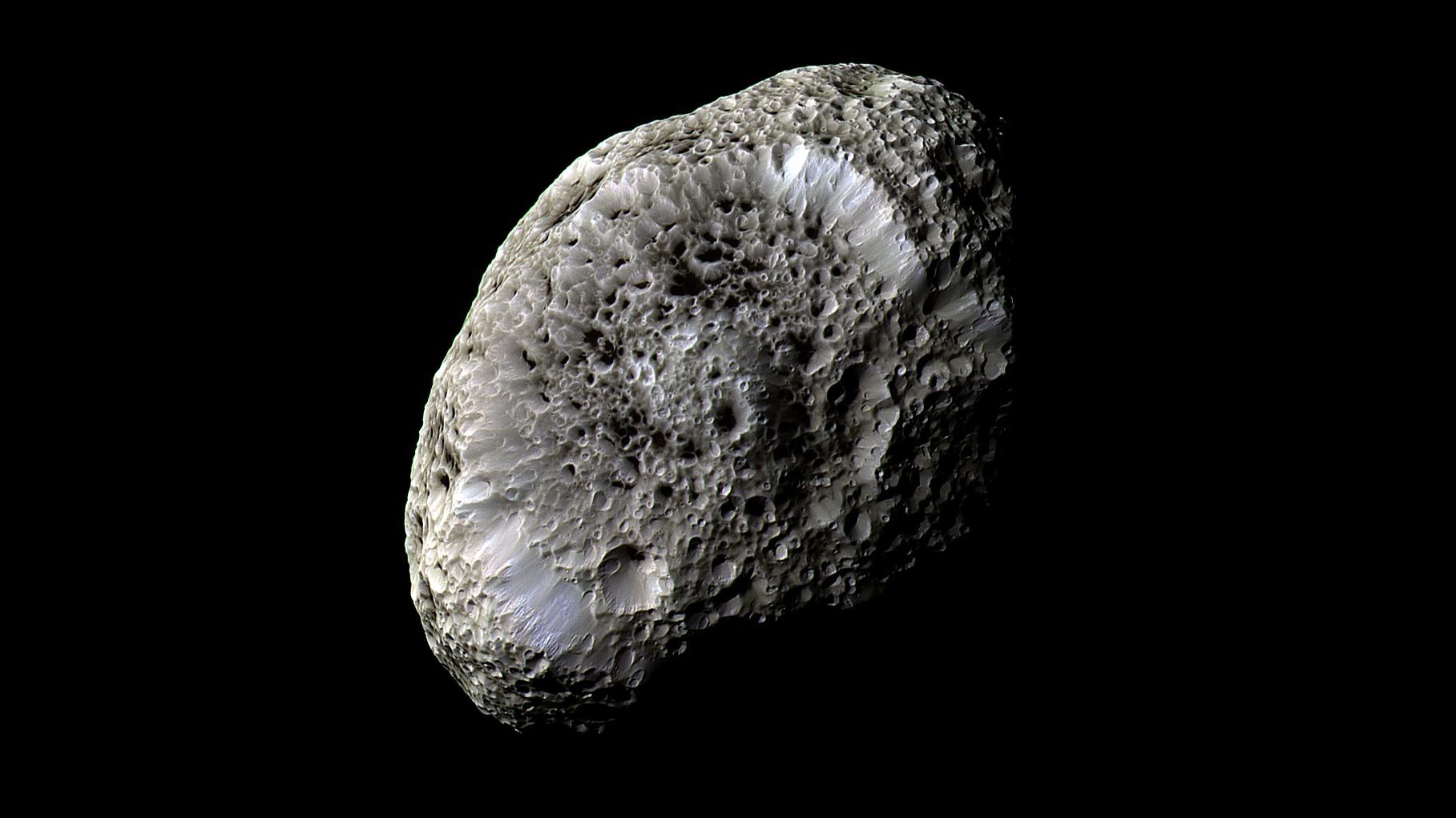
Hyperion is the strangest-looking satellite in the solar system, its surface resembling a sponge or coral with deep, dark pits rimmed by razor-sharp ridges of brighter rock and ice. But that's not the only thing that's strange about Hyperion: It was the first non-spherical moon to be discovered, and has a distinctly eccentric orbit.
Rather than matching its rotation to its orbital period, it spins in a chaotic pattern, with its axis of rotation wobbling unpredictably. Like all moons in the outer solar system, it's mostly made of water ice, but its surface is unusually dark. When Cassini flew past it measured its density to be 55% that of water — its interior is mostly empty space.
One popular theory to explain these weird features is that Hyperion is the surviving remnant of a larger satellite that once orbited between Titan and Iapetus, and which was largely destroyed by a collision with a large comet. Material that survived in a stable orbit then came together again to create Hyperion as we know it.
Titan

Saturn's largest moon Titan is unique in the solar system as the only satellite with a substantial atmosphere of its own—a discovery that frustrated NASA scientists when images from the Voyager probes revealed only a hazy orange ball. The Cassini orbiter was fitted with infrared and radar instruments that pierced the opaque atmosphere, revealing a softened landscape of rivers and lakes that is unlike any other world in the solar system, except for Earth. Despite being larger than Mercury, Titan can only hold onto its thick atmosphere because of the deep cold. Found some 0.9 billion miles (1.4 billion km) from the sun, the moon's average surface temperature is a freezing -179 degrees Celsius (-290 degrees Fahrenheit).
Titan's atmosphere is dominated by the inert gas nitrogen — also the major component of Earth's air—but it gets its distinctive color, opaque haze, and clouds from a relatively small proportion of methane. Amazingly, conditions on Titan are just right for methane to shift between its gaseous, liquid, and solid forms, generating a 'methane cycle' rather similar to the water cycle that shapes Earth's climate. In cold conditions, methane freezes onto the surface as frost and ice. In moderate temperatures, it condenses into liquid droplets and falls as rain that erodes and softens the landscape before accumulating in lakes, while in warmer regions it evaporates and returns to the atmosphere.
Titan experiences changing seasons very similar to those on our planet, though its year is 29.5 Earth years. Temperatures at the winter pole seem to favor rainfall, so the lakes migrate from one pole to the other over each Titanian year. With all this activity, Titan is an intriguing target in the search for extraterrestrial life, though most biologists find it hard to envision organisms that could exist in such harsh and chemically limited conditions, and most agree that Titan's watery inner neighbor, Enceladus, offers more promising prospects for life.
Miranda
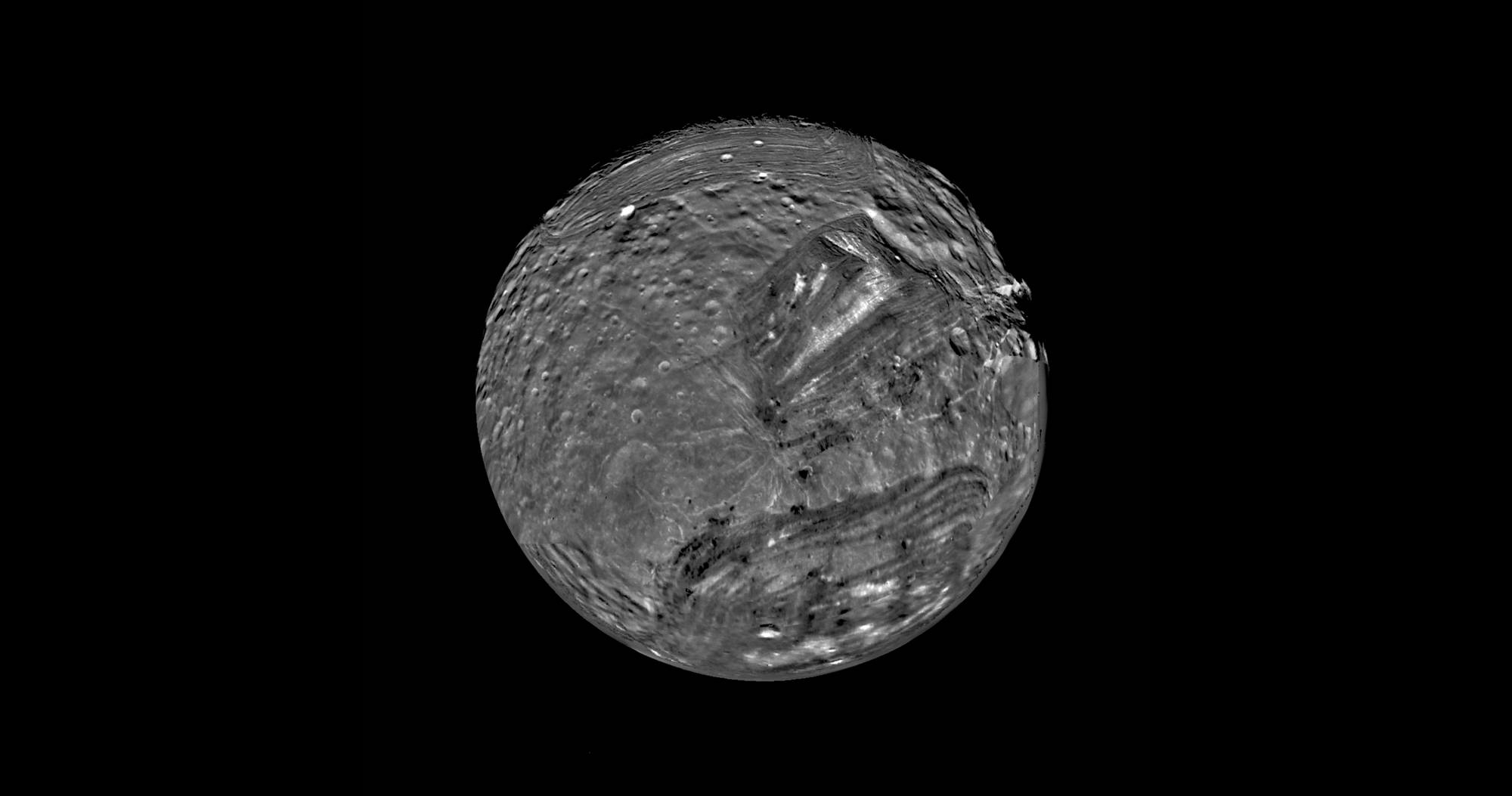
Miranda is one of the strangest worlds in the solar system. Voyager images revealed an extraordinary patchwork of terrains, seemingly put together at random. Some parts are heavily cratered and some relatively uncratered — indicating their youth, as they have been less exposed to bombardment. One prominent feature is a pattern of concentric ovals resembling a race track, while elsewhere parallel V-shapes form a chevron-like scar.
An early theory to explain Miranda's jumbled appearance is that it is a Frankenstein world—a collection of fragments from a predecessor moon that coalesced in orbit around Uranus. Astronomers wondered whether Miranda's predecessor might have been shattered by an interplanetary impact, and whether this cataclysmic event might somehow be linked to Uranus' own extreme tilt. Further studies, however, have shown that such a theory comes up short when trying to explain Miranda's mix of surface features, and the right kind of impact is unlikely. Instead it seems plausible that tidal forces are to blame.
Today Miranda follows an almost-circular orbit, but in the past its orbit was in a 'resonant' relationship with the larger moon, Umbriel. This brought the two moons into frequent alignments that pulled Miranda's orbit into an elongated ellipse that experienced extreme tidal forces. Pushed, pulled and heated from within, its surface fragmented and rearranged itself before the moons moved again and Miranda's activity subsided.
Mimas
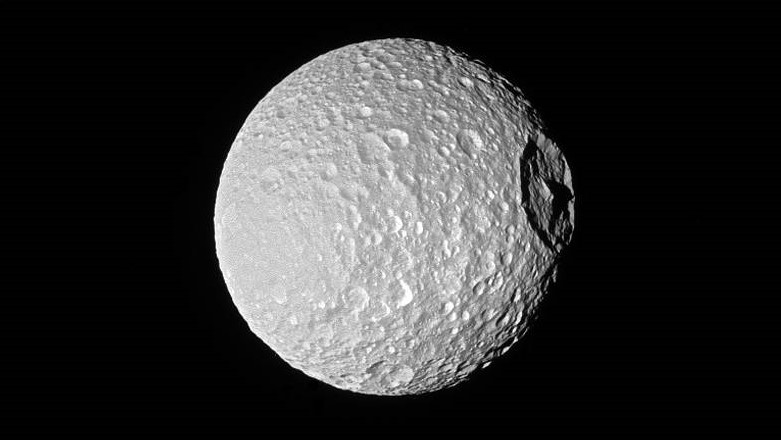
When NASA's Voyager space probes sent back the first detailed images of Mimas in the 1980s, scientists and the public were shocked by its resemblance to the Death Star from Star Wars. A huge crater — named after William Herschel, who discovered the moon in 1789 — dominates one hemisphere, and is almost the exact size and shape of the planet-killing laser dish dreamt up by George Lucas many years before. But Mimas has more to offer than pop-cultural references.
Mimas is the innermost of Saturn's substantial moons — orbiting closer than Enceladus, but further out than Pan and Atlas — and with a diameter of just 246 miles (396 km), it's the smallest object in the solar system known to have pulled itself into a spherical shape from its own gravity. Some larger solar system objects haven't quite managed this, and most astronomers agree that it's only possible for Mimas because of the moon's low density — just 15% greater than water.
Pan and Atlas
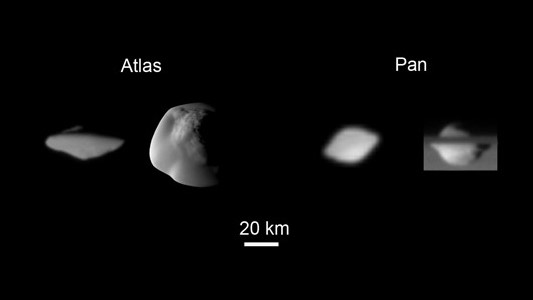
The Saturn moons, Pan and Atlas, are the smallest moons in the solar system. However, despite their size their influence can be seen clearly from Earth in the form of the prominent 'gap' they create in the planet's ring system.
These two tiny worlds are perhaps the best known examples of shepherd moons — small satellites that orbit in or around the ring systems of the giant planets. As the name suggests, when coupled with the influence of distant outer moons, such satellites help to herd the particles orbiting in the ring system together while 'clearing out' others. Pan is responsible for creating the Encke Gap, a prominent division in Saturn's bright A Ring, while Atlas orbits just outside the A Ring.
The most intriguing property of both worlds is their smooth shape, resembling a walnut or a flying saucer. Bonnie Buratti of NASA's Jet Propulsion Laboratory believes that the moons are blanketed in small particles swept up as they keep the space between the rings clear. As most of the particles orbit in a plane 0.6 miles (1 km) thick, they tend to pile up around each moon's equator, building a distinctive equatorial ridge.

After studying astronomy at University College London and Science Communication at Imperial College, Giles set out on an Exciting Adventure with Illustrated Publishing. He's since written a string of beautiful and successful books on astronomy, science and other cool subjects, and is also a regular contributor to magazines. When he's not doing the day job, you’ll find him fanboying about Doctor Who or lost in some obscure corner of history…










